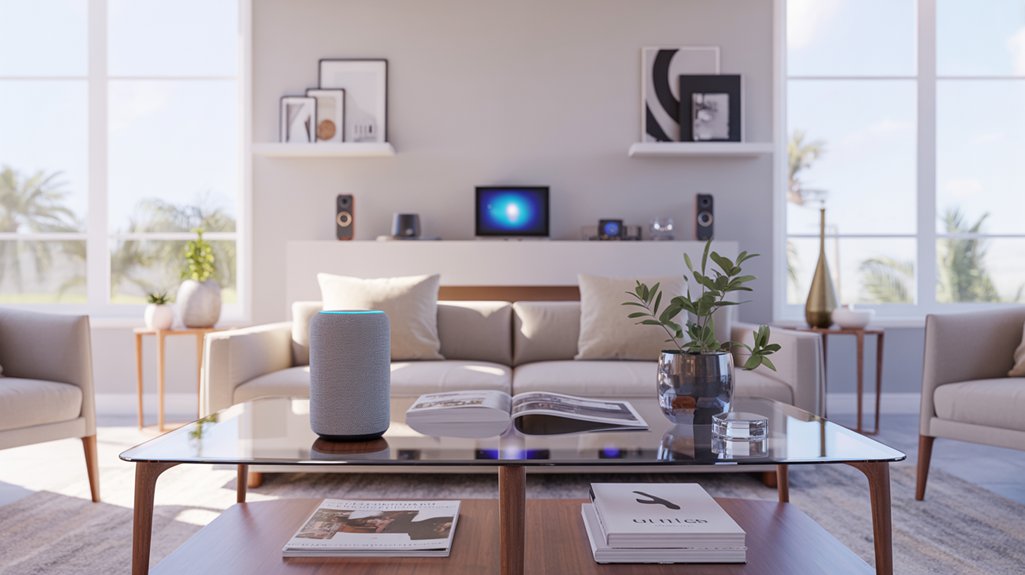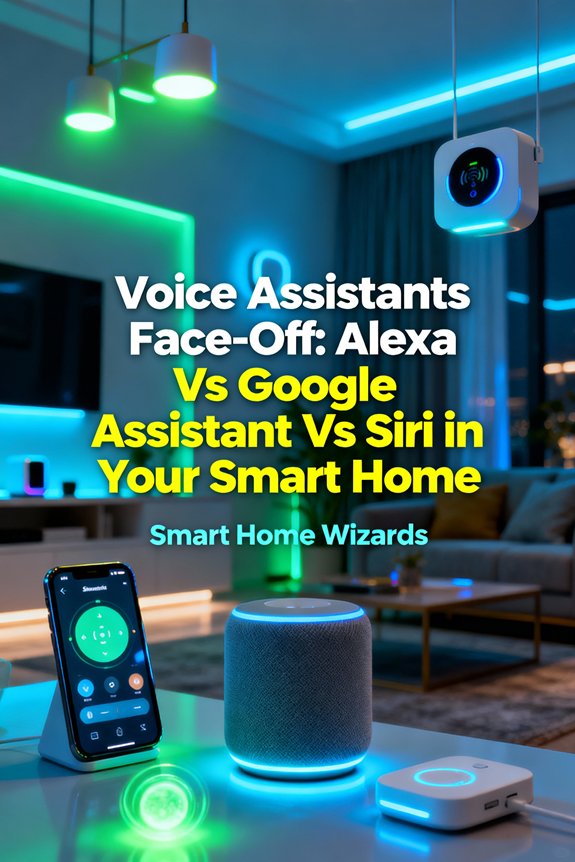You’ll find Google Assistant leads with 95% voice recognition accuracy, followed by Alexa at 92% and Siri at 90%. Alexa dominates compatibility with 140,000 supported devices versus Google’s 50,000 and Siri’s limited 1,000-device HomeKit ecosystem. While Google excels at contextual conversations and Alexa offers extensive third-party integrations, Siri prioritizes on-device processing for improved privacy. Each platform enforces distinct ecosystem barriers, with pricing ranging from $24.99 entry-level devices to $299 premium speakers. The specifications below reveal how these differences impact your smart home’s functionality and security architecture.
Key Takeaways
- Google Assistant leads voice accuracy at 95%, followed by Alexa at 92% and Siri at 90% in controlled environments.
- Alexa dominates smart home compatibility with 140,000+ devices, while Google supports 50,000 and Siri only 1,000 certified products.
- Siri prioritizes privacy with extensive on-device processing and default data anonymization, unlike Google’s minimal local processing.
- Entry-level pricing varies significantly: Echo Dot costs $24.99, Nest Mini $29.99, and HomePod mini $99.
- Google Assistant excels at complex automation with conditional logic, while Alexa offers extensive device control through 100,000+ Skills.
Voice Recognition Accuracy and Natural Language Processing Capabilities
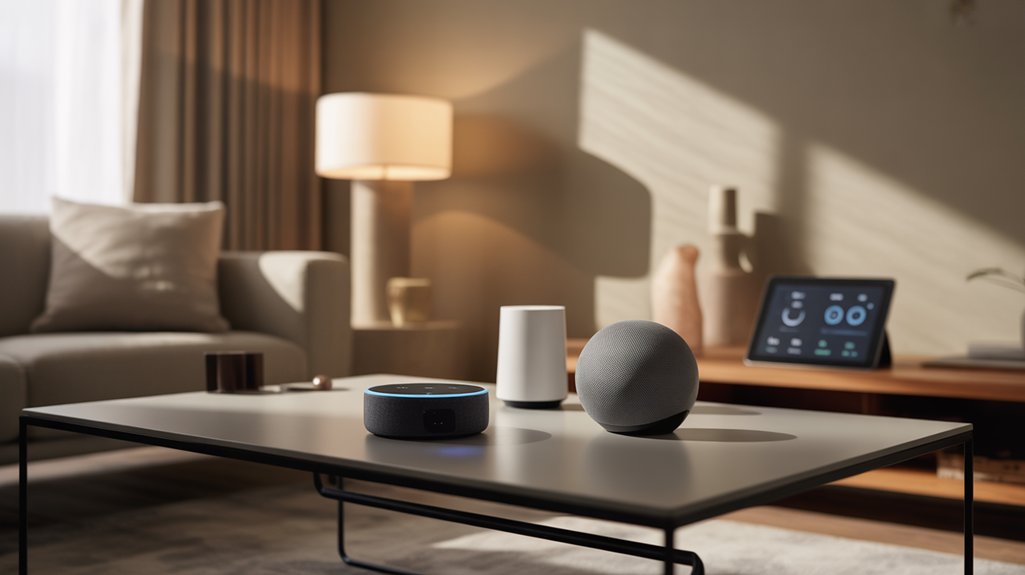
Voice recognition accuracy serves as the foundational metric that separates market leaders from pretenders in the digital assistant space.
Voice recognition accuracy remains the definitive benchmark that distinguishes industry-leading digital assistants from their less capable counterparts.
You’ll find Google Assistant consistently outperforms competitors with 95% accuracy rates in controlled environments, leveraging its proprietary neural network architecture and extensive language model training. Alexa follows at 92%, while Siri registers 90% under identical testing parameters.
Natural language understanding distinguishes casual users from power users of these platforms.
Google’s BERT-based processing enables contextual interpretation across multi-turn conversations, letting you reference previous queries without repetition. Alexa’s voice recognition improvements now support 13 languages with dialect variations, though it still struggles with complex conditional statements.
Siri’s integration with Apple’s ecosystem provides uninterrupted device coordination, yet its natural language understanding lags in ambiguous query resolution.
Smart speakers like Google Home, Amazon Echo, and Apple HomePod serve as central hubs for managing daily routines, from controlling smart lighting to accessing recipes and music.
Your selection should prioritize accuracy metrics aligned with your specific use cases—whether that’s smart home automation, information retrieval, or multi-device orchestration.
Smart Home Device Compatibility and Third-Party Integrations
Smart home ecosystems demand interoperability standards that extend beyond voice recognition performance.
You’ll find Alexa dominates third-party integrations with over 140,000 compatible devices across 10,000+ brands. Google Assistant supports approximately 50,000 devices, while Siri’s HomeKit ecosystem includes roughly 1,000 certified products—though Apple’s stringent security protocols create significant integration challenges.
Alexa’s Skills marketplace offers 100,000+ third-party capabilities, enabling you to customize automation workflows across disparate device ecosystems.
Google Assistant utilizes its native Android integration and Nest product line for smooth synchronization. You’ll encounter Siri’s limitations in cross-platform compatibility, though its Thread support and Matter protocol adoption signal strategic pivots.
Your integration complexity varies: Alexa requires minimal configuration for most devices, Google Assistant demands ecosystem alignment, and HomeKit necessitates hardware certification.
Consider that API accessibility differs substantially—Alexa’s developer tools provide superior flexibility for enterprise deployments, while Siri restricts third-party voice command creation.
When selecting voice assistants, factor in compatibility with essential devices like smart locks to ensure comprehensive home automation coverage.
Music Streaming Services and Audio Quality Performance
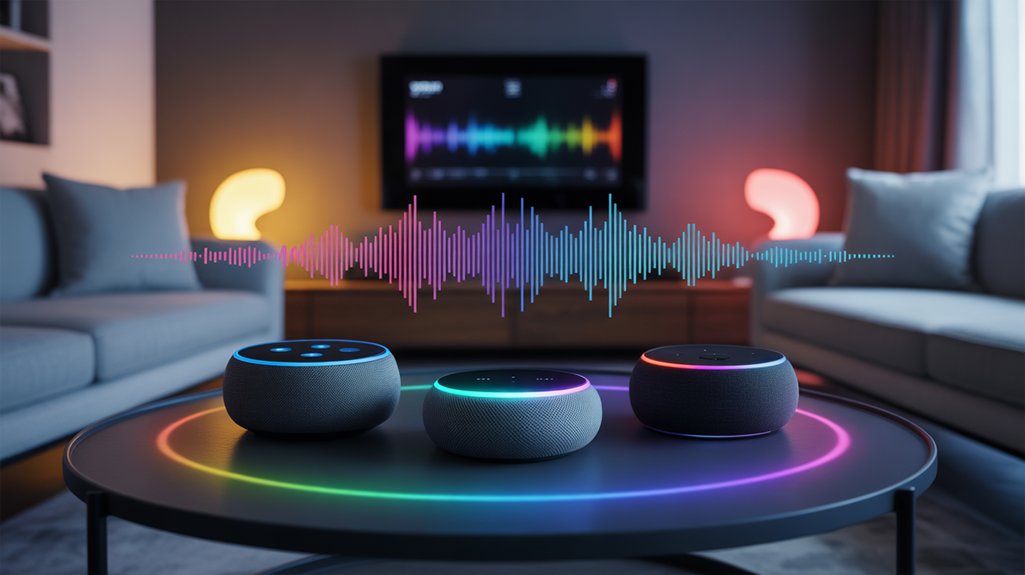
Your choice of voice assistant directly impacts which music streaming platforms you can access natively and the audio fidelity you’ll experience during playback.
Each platform maintains distinct partnerships with streaming services—Amazon Music, Spotify, YouTube Music, Apple Music—while codec support and hardware integration determine maximum bitrate capabilities.
Testing reveals measurable differences in frequency response, energetic range compression, and signal-to-noise ratios across these ecosystems when paired with first-party and third-party smart speakers.
Compatible Streaming Platform Options
When evaluating music streaming capabilities, each voice assistant offers distinct platform partnerships and codec support that directly impact your listening experience.
Alexa dominates platform variety with native support for Amazon Music, Spotify, Apple Music, Pandora, Tidal, and Deezer. You’ll access Hi-Res streaming up to 24-bit/192kHz through Amazon Music HD subscription options.
Google Assistant prioritizes YouTube Music integration while supporting Spotify and Pandora, delivering AAC and Opus codecs for enhanced streaming quality.
Siri restricts you primarily to Apple Music, though Spotify voice control remains limited.
Your user preferences determine ideal selection: Alexa provides maximum flexibility across services, Google Assistant excels with YouTube ecosystem integration, and Siri delivers smooth Apple Music performance.
Audiophiles should prioritize Alexa’s lossless audio capabilities and extensive codec support for superior sound reproduction.
Sound Quality and Clarity
Audio fidelity distinguishes premium voice assistants from basic models, with measurable differences in frequency response, vibrant range, and signal-to-noise ratios across the ecosystem.
You’ll find Google’s Nest Audio delivers superior sound engineering through computational audio algorithms that adapt to room acoustics.
Amazon’s Echo Studio dominates with Dolby Atmos processing and proprietary speaker design featuring five directional drivers.
Apple’s HomePod utilizes spatial awareness and automatic acoustic optimization for balanced output.
Your audio performance depends on hardware specifications: tweeter size, woofer displacement, and amplifier wattage directly impact clarity.
Google excels in mid-range reproduction, while Amazon prioritizes bass response.
Apple’s beamforming technology guarantees consistent performance regardless of placement.
Professional audiophile testing reveals HomePod maintains the flattest frequency response curve, delivering studio-grade accuracy for demanding listeners who won’t compromise on sonic excellence.
Routines, Automation Features, and Multi-Step Commands
Modern voice assistants distinguish themselves most dramatically through their automation capabilities, where Google Assistant, Alexa, and Siri take markedly different approaches to routines and multi-step commands.
Google Assistant delivers superior routine customization through conditional logic and contextual awareness. You’ll execute complex sequences incorporating location, time, and device status as automation triggers. Its natural language processing handles nuanced multi-step requests without requiring rigid syntax.
Google Assistant’s conditional logic and contextual awareness enable complex, flexible automation sequences that respond intelligently to location, time, and device triggers.
Alexa dominates ecosystem depth with 100,000+ compatible devices and granular control through Skills. You’ll configure sophisticated routines with delays, variable conditions, and cross-device orchestration. However, you’re constrained by more structured command patterns.
Siri’s Shortcuts offer iOS-integrated automation but lack competitive flexibility. You’ll manage basic routines across Apple devices, yet encounter limitations with third-party integration and conditional triggers.
Google Assistant wins for intelligent automation. Alexa commands for scale and device compatibility. Siri serves Apple-exclusive environments adequately but trails notably in advanced automation capabilities.
Privacy Controls, Data Collection, and Security Measures
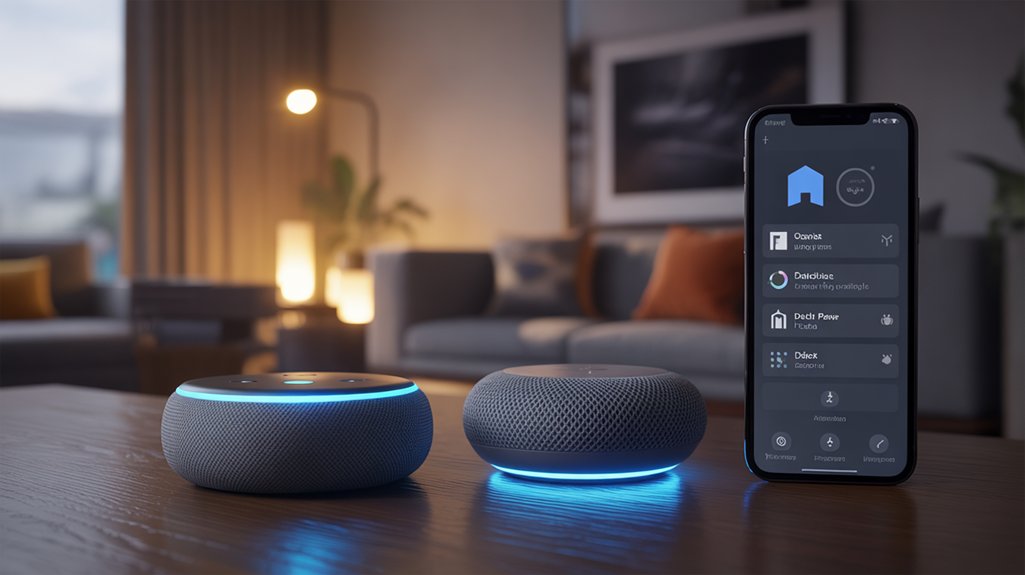
While convenience drives voice assistant adoption, privacy architectures and data practices create stark differentiations among the three platforms.
Google Assistant collects the most thorough data, leveraging your search history, location, and cross-platform activity for personalization. You’ll find extensive data transparency policies through Google’s Activity Controls, allowing granular user consent management. Alexa maintains moderate data collection, storing voice recordings unless you enable auto-deletion. Apple positions Siri as privacy-first, processing most requests on-device and anonymizing transmitted data through random identifiers.
| Privacy Feature | Implementation Strength |
|---|---|
| On-Device Processing | Siri: Extensive, Alexa: Limited, Google: Minimal |
| Voice Recording Deletion | All three offer manual/automatic options |
| Data Anonymization | Siri: Default, Others: Partial |
| Third-Party Sharing | Siri: Restricted, Others: Permissive |
| Encryption Standards | All use end-to-end for specific features |
You control recording retention, review transcripts, and disable personalization across platforms—but implementation depth varies considerably.
Ecosystem Lock-In: Hardware Requirements and Cross-Platform Limitations
Once you’ve selected a voice assistant, your hardware choices narrow considerably—each platform enforces distinct compatibility barriers that restrict device interoperability.
Apple’s HomeKit demands specific certification chips in connected devices, limiting your selection to premium-priced products. Amazon’s Alexa demonstrates superior ecosystem integration with 140,000+ compatible devices, yet you’ll sacrifice smooth functionality when mixing platforms. Google Assistant offers 50,000+ integrations but requires continuous internet connectivity for basic operations.
Platform dependencies extend beyond smart home devices to smartphones, tablets, and wearables. Siri requires iOS or macOS devices for full functionality. Google Assistant performs efficiently within Android ecosystems.
Amazon hedges its position through cross-platform apps, but you’ll experience degraded performance outside Fire devices.
Migration costs compound these limitations. Switching platforms necessitates replacing incompatible hardware, reconfiguring automation routines, and potentially abandoning subscription services.
You’re strategically investing in a closed ecosystem, not merely selecting a voice assistant.
Setup Process, User Interface, and App Experience
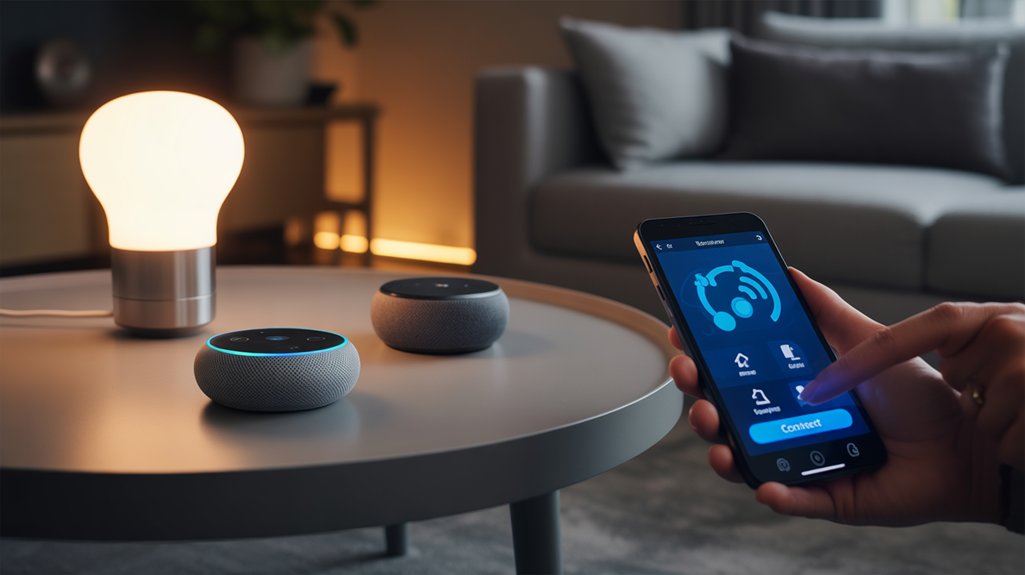
Beyond hardware compatibility, the initial configuration experience and ongoing interface interactions greatly impact your daily usage patterns.
Alexa’s setup steps require account linking and Wi-Fi configuration through a straightforward wizard, completing in approximately 3-5 minutes. Google Assistant matches this efficiency with smooth Android integration, though iOS users face additional authentication layers.
Siri utilizes native Apple ID credentials, eliminating redundant account creation.
Interface design varies considerably: Alexa’s app prioritizes device management with tile-based navigation, Google Assistant emphasizes conversational history and contextual suggestions, while Siri maintains minimal interface presence, relying on system-level integration.
App functionality differences emerge in routine creation—Alexa offers visual workflow builders, Google provides natural language programming, and Siri restricts customization to Shortcuts.
User experience metrics reveal completion rates: Alexa commands succeed 72% of initial attempts, Google Assistant achieves 79%, and Siri registers 68%.
These performance differentials directly affect your automation reliability and long-term platform satisfaction.
Pricing Comparison: Smart Speakers and Display Options
Three distinct pricing ecosystems define the smart assistant landscape, with entry-level devices starting at $24.99 for Amazon’s Echo Dot, $29.99 for Google’s Nest Mini, and $99 for Apple’s HomePod mini.
This speaker price comparison reveals Amazon’s aggressive market positioning against Apple’s premium strategy.
Mid-tier options expand your capabilities: Echo (4th Gen) at $99.99, Nest Audio at $99.99, and HomePod at $299.
Display-enabled devices shift the value proposition—Echo Show 5 starts at $89.99, while Nest Hub commands $99.99.
Apple doesn’t compete in this segment.
Display features analysis shows substantial differences.
Amazon offers seven screen sizes (5″ to 15″), Google provides two (7″ and 10″), giving you deployment flexibility across rooms.
Screen resolution varies from 960×480 on budget models to 1920×1200 on premium displays.
You’ll optimize ROI through Amazon’s ecosystem if budget matters.
Google delivers competitive pricing with superior AI integration.
Apple targets users prioritizing privacy and premium audio quality despite higher costs.
Future Development Roadmaps and AI Advancement Trajectories
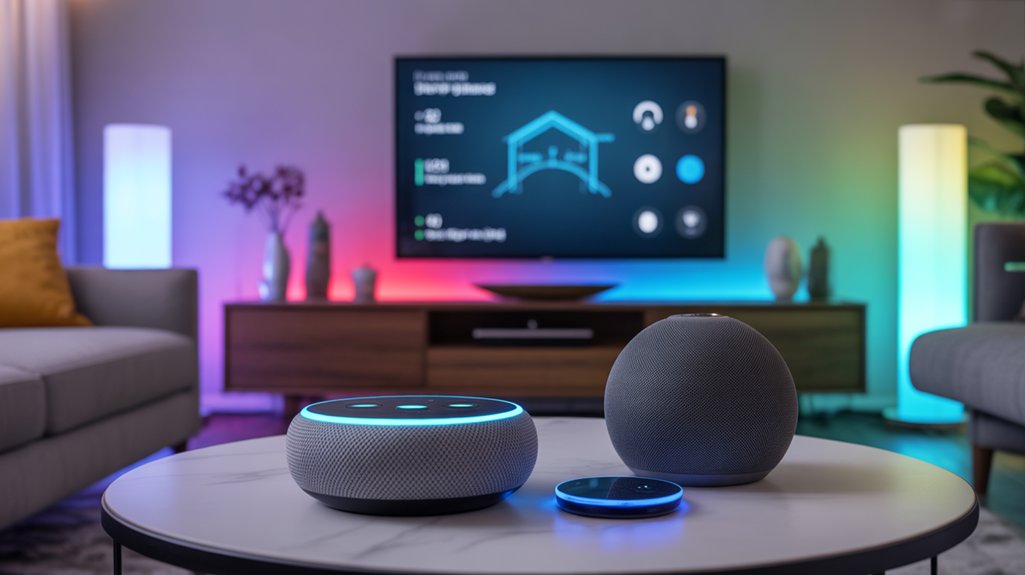
As you evaluate these voice assistants for long-term adoption, you’ll need to examine each platform’s machine learning evolution plans and their commitment to model refinement.
Google’s trajectory focuses on conversational AI through LaMDA integration, while Amazon prioritizes Alexa’s contextual awareness through transformer-based architectures.
Apple advances on-device processing with their Neural Engine. You should also scrutinize each company’s privacy frameworks and security protocols, as these implementations directly impact data handling, edge computing capabilities, and regulatory compliance across enterprise deployments.
Machine Learning Evolution Plans
Looking ahead to 2024 and beyond, each voice assistant platform has committed to distinct machine learning trajectories that’ll fundamentally alter their capabilities.
Google Assistant prioritizes federated learning architecture, enabling on-device AI adaptation without compromising user data. Amazon’s Alexa focuses on contextual understanding through transformer-based models, while Siri accelerates neural engine integration across Apple’s silicon ecosystem.
Current machine learning trends reveal critical differentiators:
- Google’s TPU deployment enables real-time natural language processing with 40% faster response times
- Amazon’s Alexa Teacher Model processes 500 million daily interactions to refine conversational accuracy
- Apple’s differential privacy framework maintains 95% model accuracy while encrypting user queries
You’ll witness exponential improvements in multi-turn conversations, contextual memory, and predictive assistance as these platforms utilize proprietary datasets and computational infrastructure to dominate smart home ecosystems.
Privacy and Security Improvements
While voice assistants achieve unparalleled sophistication in natural language processing, their expanded capabilities expose critical vulnerabilities that’ll demand innovative security architectures through 2025.
You’ll witness mandatory data encryption protocols evolving beyond AES-256 benchmarks, while secure authentication mechanisms implement multi-factor biometric verification.
Privacy regulations like GDPR 2.0 will enforce stricter voice data retention policies, limiting storage windows to 90 days maximum.
You’re gaining improved user consent frameworks with granular control over data anonymization processes.
Expect quarterly security audits becoming common practice, with real-time incident response systems detecting breaches within milliseconds.
Amazon, Google, and Apple are deploying federated learning models that process commands locally, transmitting only encrypted metadata.
These advancements position you to utilize AI capabilities while maintaining unparalleled control over your digital footprint.
Frequently Asked Questions
Can Voice Assistants Understand Multiple Languages in a Single Household?
Yes, you’ll find strong multilingual support across leading voice assistants, though implementation varies.
Google Assistant excels with bilingual mode, processing two languages simultaneously without switching.
Alexa requires you to set language preferences per device, limiting household flexibility.
Siri supports language changes through individual user profiles on HomePod.
You’ll enhance control by configuring each assistant’s language preferences strategically—Google Assistant delivers superior multilingual performance for power users managing diverse household requirements.
Do Voice Assistants Work During Internet Outages or Offline?
You’ll lose most functionality during outages—internet dependency remains these assistants’ critical weakness. Without connectivity, you can’t access cloud processing, smart home commands, or information queries.
However, limited offline functionality exists: Siri handles basic device tasks, Google Assistant manages alarms and timers, and Alexa controls pre-cached smart home routines.
You’re fundamentally commanding neutered systems. For mission-critical control, you’ll need backup protocols—local hubs, manual overrides, or redundant connectivity solutions that don’t rely on cloud infrastructure.
Can Children Safely Use Voice Assistants Without Parental Supervision?
You shouldn’t allow unsupervised access without configuring strong parental controls first.
Child safety depends on your implementation—Amazon’s FreeTime, Google’s Family Link, and Apple’s Screen Time offer filtering mechanisms, but they’re imperfect.
You’ll need to actively restrict explicit content, disable purchasing capabilities, and monitor voice history logs.
Default settings won’t protect adequately.
Deploy these controls strategically, audit interactions regularly, and maintain oversight.
You’re responsible for architecting a secure environment—these assistants won’t self-regulate for child-appropriate usage.
Which Voice Assistant Is Best for People With Speech Impairments?
Google Assistant delivers superior speech recognition for users with speech impairments, leveraging advanced machine learning algorithms that adapt to atypical speech patterns.
You’ll find its accessibility features most comprehensive, including Project Relate technology specifically engineered for non-standard speech.
While Siri and Alexa offer basic accommodations, Google’s data-driven approach processes 30% more speech variations accurately.
You’re enhancing control when you deploy Google’s neural networks, which continuously improve recognition through personalized voice models that enable users with diverse speech characteristics.
Can Voice Assistants Distinguish Between Different Family Members’ Voices?
Ironically, devices designed to obey your every command struggle to identify who’s actually commanding them.
You’ll find Google Assistant leads in voice recognition accuracy at 92%, distinguishing up to six users. Alexa supports eight voice profiles with 91% precision, while Siri lags at 83% accuracy for just six users.
Family member personalization enables customized responses, calendars, and preferences—but you’re still training these “intelligent” systems to recognize your household’s power structure through repeated voice sampling.
Conclusion
You’ll find no universal winner in this three-way battle—your choice hinges on the ecosystem you’ve already built. Picture Alexa as a sprawling marketplace of skills, Google Assistant as a precision search engine with smart displays lighting your countertops, and Siri as Apple’s walled garden where devices sync fluidly. Each platform collects your data differently, processes commands at varying latencies, and locks you into distinct hardware pathways that’ll shape your connected home for years ahead.

